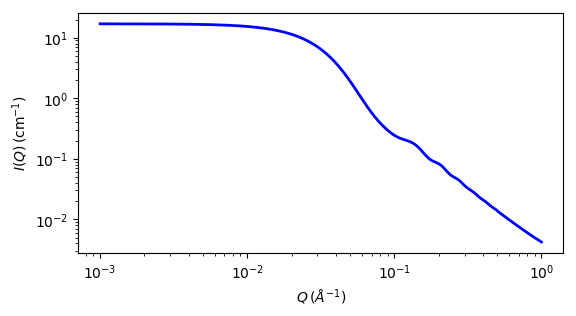polymer_micelle
Polymer micelle model
| Parameter | Description | Units | Default value |
|---|---|---|---|
| scale | Scale factor or Volume fraction | None | 1 |
| background | Source background | cm-1 | 0.001 |
| ndensity | Number density of micelles | 1015cm3 | 8.94 |
| v_core | Core volume | Å3 | 62624 |
| v_corona | Corona volume | Å3 | 61940 |
| sld_solvent | Solvent scattering length density | 10-6Å-2 | 6.4 |
| sld_core | Core scattering length density | 10-6Å-2 | 0.34 |
| sld_corona | Corona scattering length density | 10-6Å-2 | 0.8 |
| radius_core | Radius of core ( must be >> rg ) | Å | 45 |
| rg | Radius of gyration of chains in corona | Å | 20 |
| d_penetration | Factor to mimic non-penetration of Gaussian chains | None | 1 |
| n_aggreg | Aggregation number of the micelle | None | 6 |
The returned value is scaled to units of cm-1 sr-1, absolute scale.
This model provides the form factor, P(q), for a micelle with a spherical core and Gaussian polymer chains attached to the surface, thus may be applied to block copolymer micelles. To work well the Gaussian chains must be much smaller than the core, which is often not the case. Please study the reference carefully.
Definition
The 1D scattering intensity for this model is calculated according to the equations given by Pedersen (Pedersen, 2000), summarised briefly here.
The micelle core is imagined as N = n_aggreg polymer heads, each of volume Vcore, which then defines a micelle core of radius r = r_core, which is a separate parameter even though it could be directly determined. The Gaussian random coil tails, of gyration radius Rg, are imagined uniformly distributed around the spherical core, centred at a distance r+d⋅Rg from the micelle centre, where d = d_penetration is of order unity. A volume Vcorona is defined for each coil. The model in detail seems to separately parametrise the terms for the shape of I(Q) and the relative intensity of each term, so use with caution and check parameters for consistency. The spherical core is monodisperse, so it’s intensity and the cross terms may have sharp oscillations (use q resolution smearing if needs be to help remove them).
where ρcore, ρcorona and ρsolvent are the scattering length densities sld_core, sld_corona and sld_solvent. For the spherical core of radius r
whilst for the Gaussian coils
The sphere to coil (core to corona) and coil to coil (corona to corona) cross terms are approximated by:
Validation
P(q) above is multiplied by ndensity, and a units conversion of 10−13, so scale is likely 1.0 if the scattering data is in absolute units. This model has not yet been independently validated.

Fig. 86 1D plot corresponding to the default parameters of the model.
Source
polymer_micelle.py
⋆ polymer_micelle.c
⋆ lib/sas_3j1x_x.c
References
- J Pedersen, J. Appl. Cryst., 33 (2000) 637-640
Authorship and Verification
- Translated by : Richard Heenan Date: March 20, 2016
- Last modified by: Paul Kienzle Date: November 29, 2017
- Last reviewed by: Steve King Date: November 30, 2017